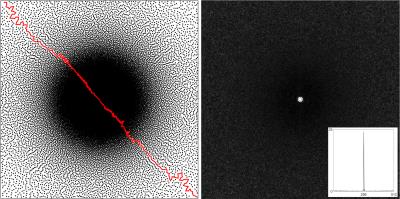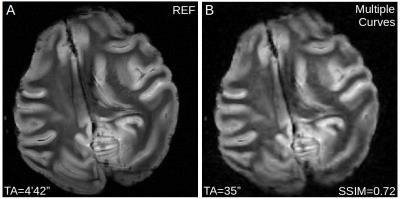1529
SPARKLING: Novel Non-Cartesian Sampling Schemes for Accelerated 2D Anatomical Imaging at 7T Using Compressed Sensing1CEA/NeuroSpin, INRIA/Parietal, Gif-sur-Yvette Cedex, France, 2CNRS/ITAV, Toulouse, France, 3Siemens Healthineers, Saint-Denis, France, 4CEA/NeuroSpin, Gif-sur-Yvette Cedex, France
Synopsis
We present for the first time the implementation of novel non-Cartesian trajectories on a 7T scanner for 2D anatomical imaging. The proposed SPARKLING curves (Segmented Projection Algorithm for Random K-space sampLING) are a new type of non-Cartesian segmented sampling trajectories which allow fast and efficient coverage of the k-space according to a chosen variable density [1]. To demonstrate their potential, a high-resolution (0.4x0.4x3.0mm3) T2*-weighted image was acquired with an 8-fold undersampled SPARKLING trajectory. Images were reconstructed using non-linear iterative reconstructions derived from the Compressed Sensing theory.
Introduction
Non-Cartesian trajectories present many benefits compared to classic Cartesian ones: they allow rapid and efficient coverage of the k-space, contain fewer coherent artifacts from undersampling [2] and can be more robust to motion [3,4]. In particular, radial readouts showed many successes in dynamic imaging with the GRASP method notably [5,6]. More recently, spiral trajectories combined with non-Cartesian SENSE also demonstrated the advantages of such methods for high-speed and high-resolution imaging [7].
In this work, we propose to use "SPARKLING” curves (Segmented Projection Algorithm for Random K-space sampLING) as a new type of non-Cartesian trajectories to perform a more efficient sampling in 2D anatomical imaging while using the same number of samples for a limited time budget. These segmented curves were obtained using a projection method on measure sets presented in [1,8] which offers three main advantages: i) generating segmented Non-Cartesian trajectories along a chosen density; ii) meeting the hardware constraints on the magnetic field gradients (magnitude, slew rate); iii) performing a fast coverage of k-space. Simulations on retrospective Compressed Sensing (CS) proved the superiority of such approach as compared to classical 2D undersampled schemes such as radial or spiral readouts [1], which encouraged us to implement them.
As a first prospective application on a 7T scanner, we acquired the proposed SPARKLING trajectories undersampled by a factor of 8 for a high targeted resolution of 0.4x0.4x3.0mm3.
Materials and Methods
Setup:
An ex vivo baboon brain in fluorinert solution was scanned with a 7T system (Siemens Healthineers, Erlangen, Germany), 1-channel transmit, 1-channel receive coil (InVivo Corp., Gainesville, FL, USA). Maximum gradient and slew rate magnitudes on this scanner were respectively 50 mT/m and 333 T/m/s.
Sequence and k-space trajectories:
A modified 2D T2*-weighted GRE sequence was acquired with the following parameters: TR=550 ms, TE=30 ms and FA=25° for one axial slice of thickness 3mm. The SPARKLING trajectory (Fig.1-A) was generated by the algorithm presented in [1] for an image matrix size of N=512, corresponding to a 0.4 mm in plane resolution, and a variable density with a polynomial decay of 2. The trajectory was segmented into 64 shots each acquiring 512 samples during a readout time of 30 ms and crossing the center of k-space at their middle point. Total acquisition time (TA) was 35 seconds, which is 8 times shorter than the fully sampled reference acquisition of 512 Cartesian lines composed of 512 samples (TA=4'42"). The value of the acceleration factor was selected considering the image matrix size and the available SNR [9].
Reconstruction:
Nonlinear non-Cartesian reconstructions were implemented using FISTA algorithm [10] and the Nonuniform Fast Fourier Transform (NFFT) [11] for solving the regularized L1-L2 minimization problem in the wavelet domain.
Image quality evaluation:
To assess the image quality of the reconstructed image, we computed its SSIM index [12], measuring their similarity in structure with the fully sampled Cartesian reference image and whose quality scores can vary between 0 (null correspondance) and 1 (perfect match).
Results
The Point Spread Function (PSF) of the proposed SPARKLING scheme was computed for the considered reconstruction (Fig.1-B). The PSF profile offers a very well-defined central peak (see smaller window on Fig.1-B) with incoherent peripheral texture, which is particularly appropriate in the context of Compressed Sensing.
The reconstructed images are presented in Fig.2 for A) the fully sampled Cartesian reference acquisition and B) the presented 8-fold undersampled SPARKLING acquisition. The image acquired with the SPARKLING method yields not only good visual quality with but also shows a high SSIM score of 0.72. Despite the large acceleration factor, the major detailed structures of folded patterns were preserved in the subsampled acquisition.
Discussion and Conclusion
This first implementation on a 7T scanner of original sampling curves showed the practical feasibility of the SPARKLING trajectories developed in [1] and their potential as new efficient non-Cartesian sampling schemes.
We expect to further improve the resulting image quality by taking into account gradient imperfections and B0 inhomogeneities [13] and by using phased array receiving coils which will increase the available SNR. More advanced reconstruction methods will also be developed. Moreover, image quality performances of the proposed method will be compared to other ordinary non-Cartesian sampling schemes such as radial and spiral ones.
This work opens up new perspectives for more efficient non-Cartesian sampling with promises of very large acceleration factors not only in 2D anatomical imaging but also in other applications such as 3D imaging or fMRI. Most interestingly, these generic SPARKLING trajectories are perfectly compatible with all the aforementioned popular applications of non-Cartesian trajectories with higher benefits regarding image recovery at a given acquisition time.
Acknowledgements
The authors wish to acknowledge the COSMIC project funded by the DRF-Impulsion of CEA, as well as the IRTELIS international PhD program.References
[1] Boyer, Claire, et al. "On the generation of sampling schemes for Magnetic Resonance Imaging." SIAM Imaging Science (2016). In press.
[2] Peters, Dana C., et al. "Characterizing radial undersampling artifacts for cardiac applications." Magnetic resonance in medicine 55.2 (2006): 396-403.
[3] Glover, G. H., and J. M. Pauly. "Projection reconstruction techniques for reduction of motion effects in MRI." Magnetic Resonance in Medicine 28.2 (1992): 275-289.
[4] Liao, Jan-Ray, et al. "Reduction of motion artifacts in cine MRI using variable-density spiral trajectories." Magnetic resonance in medicine 37.4 (1997): 569-575.
[5] Jung, Hong, et al. "k-t FOCUSS: A general compressed sensing framework for high resolution dynamic MRI." Magnetic Resonance in Medicine 61.1 (2009): 103-116.
[6] Feng, Li, et al. "XD-GRASP: Golden-angle radial MRI with reconstruction of extra motion-state dimensions using compressed sensing." Magnetic resonance in medicine 75.2 (2016): 775-788.
[7] Kasper, Lars, et al. Spiral Acquisition for High-Speed Anatomical Imaging at 7T. ISMRM 24th Annual Meeting & Exhibition (2016). Abstract n°741.
[8] Chauffert, Nicolas, et al. A Projection Algorithm for Gradient Waveforms Design in Magnetic Resonance Imaging. IEEE transactions on medical imaging 35.9 (2016): 2026-2039.
[9] Lazarus, Carole, et al. Compressed Sensing in MRI: how the Maximum Undersampling Factor depends on the Image Size. ESMRMB 2016 Congress. ePoster n°127.
[10] Beck, Amir, and Marc Teboulle. "A fast iterative shrinkage-thresholding algorithm for linear inverse problems." SIAM journal on imaging sciences 2.1 (2009): 183-202.
[11] Keiner, J., Kunis, S., and Potts, D. Using NFFT 3 - a software library for various nonequispaced fast Fourier transforms. ACM Trans. Math. Software, 36 (2009): Article 19, 1-302
[12] Wang, Zhou, et al. "Image quality assessment: from error visibility to structural similarity." IEEE transactions on image processing 13.4 (2004): 600-612.
[13] Vannesjo, Signe J., et al. "Gradient system characterization by impulse response measurements with a dynamic field camera." Magnetic resonance in medicine 69.2 (2013): 583-593.
Figures

